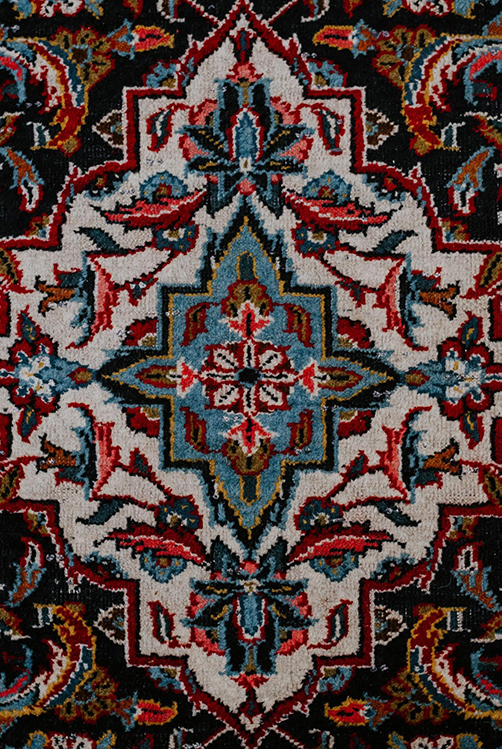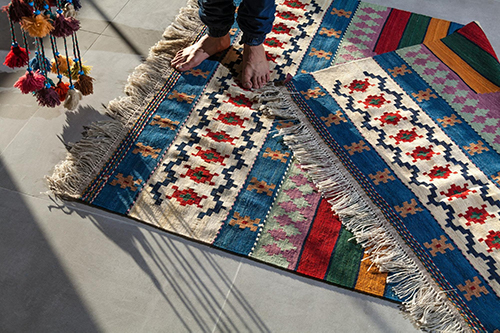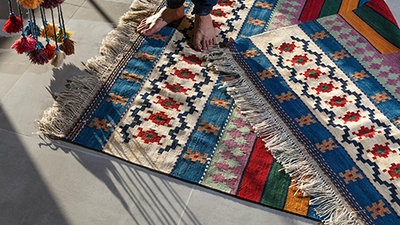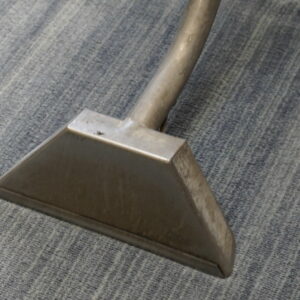Now that we know what rugs are made of, let’s talk about the different types of rugs.
There are many styles of rugs based on where they are produced, the designs they typically have, and their materials. Rugs are often made of various blends of material, sometimes interwoven together and other times with one material type in the rug center and another material on the edge and fringe.
Of course, the most well-known rugs are Persian, also known as Persian carpets. Persian rugs are almost exclusively made in Iran. They have an intricate pattern and are often seen as the pinnacle of rug-making, the gold standard by which to compare other rugs.They are usually made of a mix of wool and cotton, and occasionally silk. Cotton usually comprises the underlying structure for the rug, while wool and/or silk makes up the raised surface of the rug and forms the pattern Persian rugs are known for. There are a large number of styles of Persian rugs depending on the city in which they are made. Persian rugs should be professionally cleaned every 2 to 3 years in order to ensure their integrity and beauty. Fun fact: The first mention of Persian carpets dates back to around 400 BC (Persian carpet, 2020)!

Although Persian rugs are considered to be the most exquisite, Oriental rugs are a close contender.
While Persian rugs are made specifically in Iran, Oriental rugs are made in an area called the “Rug Belt”, which includes Northern Africa, the Middle East, Central Asia, and parts of Southern and Northern Asia (Oriental rug, 2020). They are typically made of wool, cotton, and sometimes silk. Oriental rug designs have a medallion pattern in the middle, surrounded by several borders. The designs and pictures in oriental rugs often have some sort of meaning, whether that be religious pictures, the signature of the rug maker, or even specific dates. Oriental rugs, like their Persian counterparts, should be professionally cleaned every 2 to 3 years. Fun fact: The oldest preserved rug, called the Pazyryk carpet, dates back to around 500 BC (Oriental rug, 2020)!
Haitian cotton rugs, although not as well known as the first two, are surprisingly common in Ventura County.
What makes Haitian cotton special is that it is not fully processed, so bits of seeds and other plant materials remain in the fibers (Haddad’s Rug Company, n.d.). As such, Haitian cotton rugs tend not to be colored and instead retain their natural white, yellow, and/or brown colors. Haitian cotton rugs are notoriously difficult to clean because the seeds that remain in the fibers let out a brown dye when wet, which can make a stain on the rug that may be impossible to remove (Haddad’s Rug Company, n.d.). Therefore, you should take them to a professional cleaner every 1 to 2 years. Professional cleaners will have access to cleaning materials that can properly clean your Haitian cotton rugs without damaging them.

Dhurries are an up-and-coming trend in rug fashion because they are colorful, inexpensive, and often made of natural materials (Schwartz, 2020).
Dhurries are produced in India and South Asia and are typically made from silk, cotton, wool, or jute (a coarse fiber often made into burlap or rope) (Schwartz, 2020). One unique fact about dhurries is that, because of the way they are woven, they have the same pattern on both sides. Therefore, you can flip them over if they get worn out on one side. It is recommended that you take them to a professional cleaning facility every 1 to 2 years because they can be difficult to clean and need to be thoroughly cleaned on both sides (Amirkhan & Groseclose, 2010).
Lastly, tufted rugs are gaining increasing popularity as more and more people invite rugs into their homes.
Tufted rugs are made by looping yarn through a backing with a machine and then cutting the loops to make an even surface. Because of the way they are made, tufted rugs are generally inexpensive and can have unique shapes and designs. Some people even have hand-held tufting guns at home! Tufted rugs are woven onto a backing that is then treated with an adhesive and attached to a secondary backing, which makes them susceptible to tearing at the seams (Amirkhan & Groseclose, 2010). For this reason, you should take tufted rugs to a professional cleaning facility every 1 to 2 years.
These cleaning recommendations are useful, but if your rug is in a high-traffic area, you should get them professionally cleaned more frequently. Kelly Cleaning has the knowledge, skill, and technology that is necessary to clean your rugs. We will pamper your rugs as we give them the attention they deserve. Next year, Kelly Cleaning will open the Kelly Ultimate Rug Spa, the number one destination for your precious rugs.
References
Amirkhan, E., & Groseclose, A. (2010). A Comprehensive Guide to Oriental & Specialty Rug Cleaning (2nd ed.). Master Rug Cleaner, LLC.
Haddad’s Rug Company. (n.d.). Haitian Cotton. Haddad’s Rug Company. https://www.haddadsrug.com/haitian-cotton
Oriental rug. (2020). Retrieved September 28, 2020 from https://en.wikipedia.org/wiki/Oriental_rug
Persian carpet. (2020). Retrieved September 28, 2020 from https://en.wikipedia.org/wiki/Persian_carpet
Schwartz, O. (2020). 6 Modern Rug Trends to Watch in 2020. Nazmiyal Collection. https://nazmiyalantiquerugs.com/blog/modern-rug-trends-2020/




